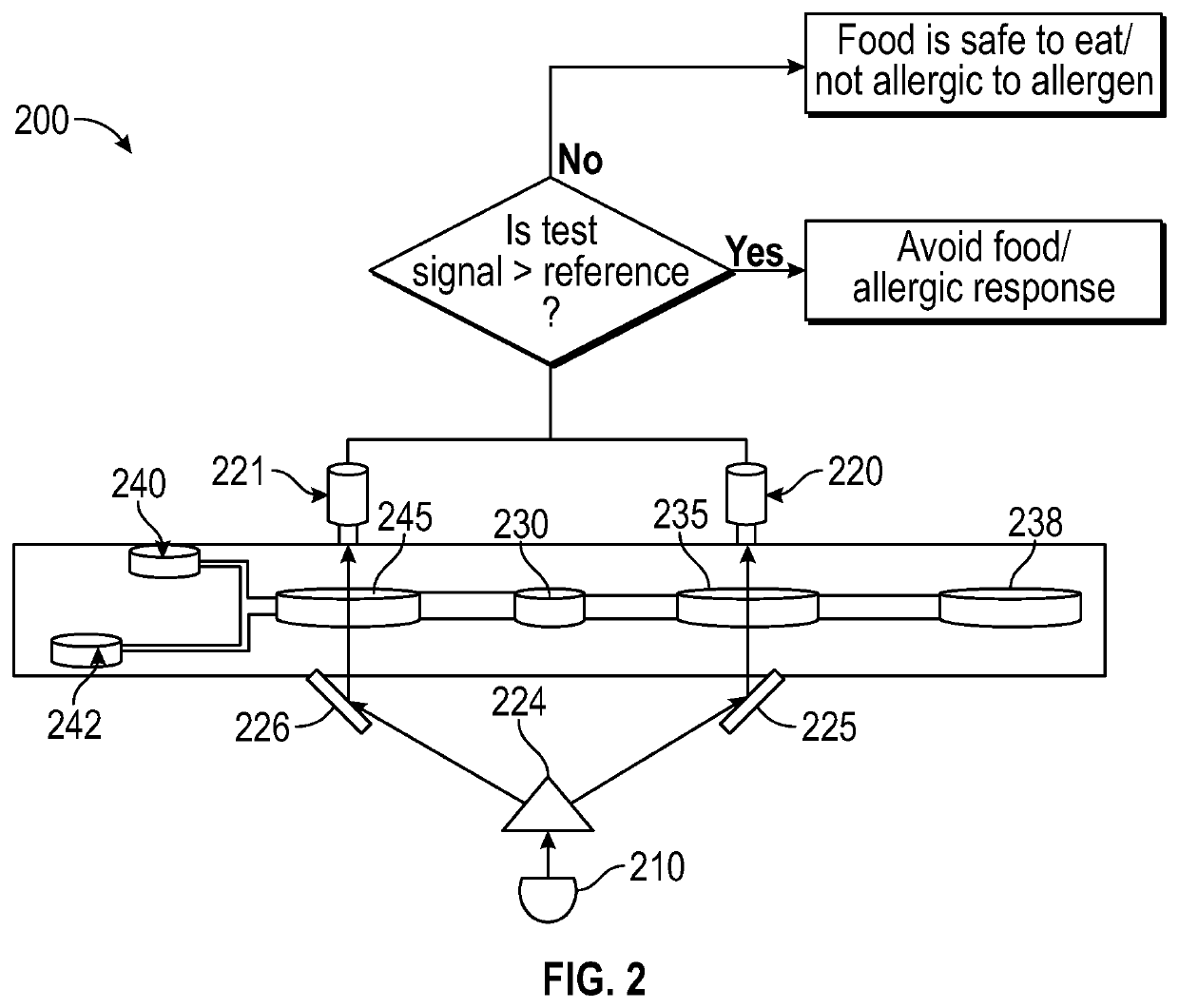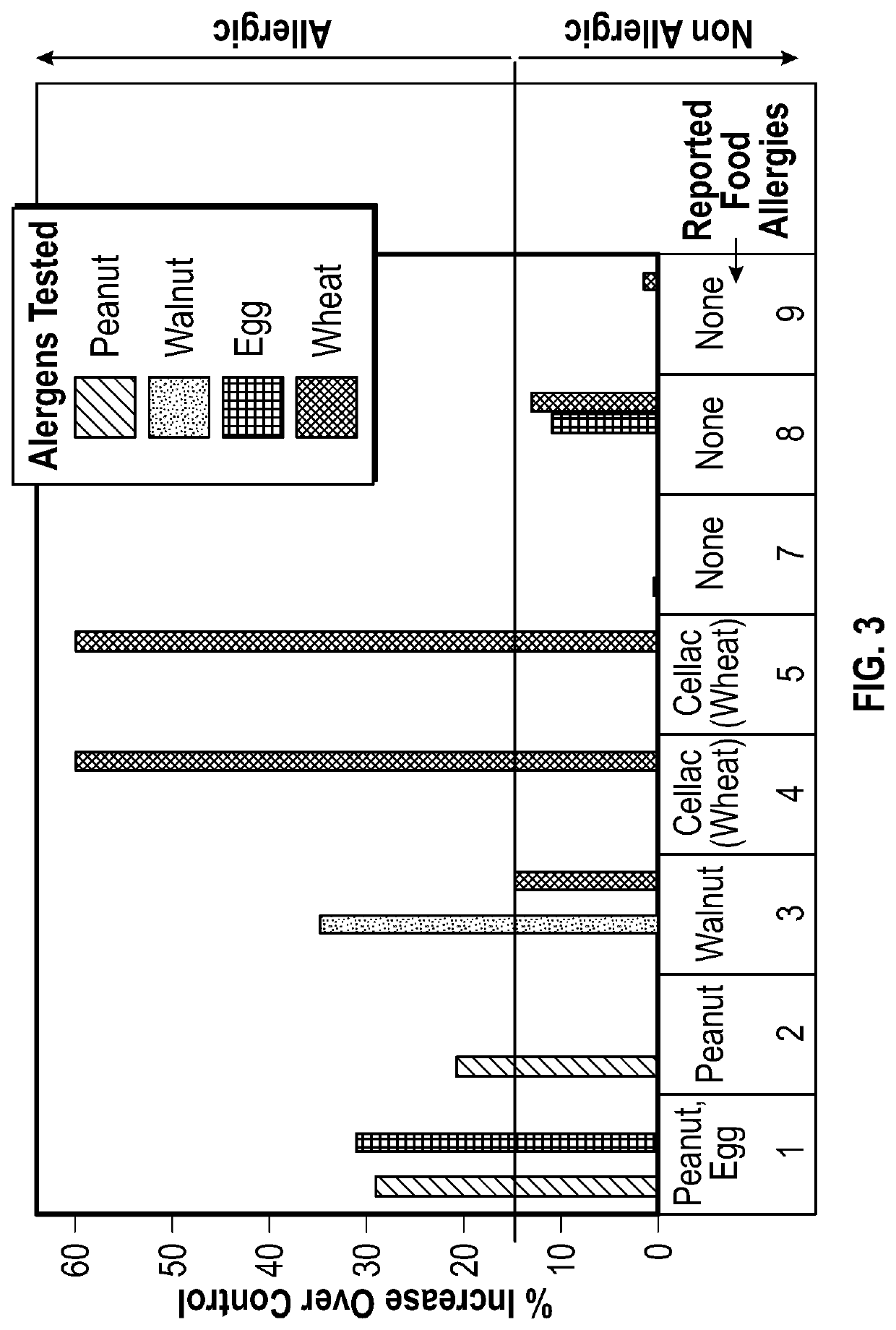Methods for testing for food allergies and allergens in foods
a technology for allergens and food allergies, applied in the field of food allergy and allergen testing, can solve the problems that allergic reactions caused by other antibodies cannot be detected through skin-prick tests, does not work for every patient, etc., and achieves the effects of convenient time after collection, stable in phosphate buffer, and easy and safe collection
- Summary
- Abstract
- Description
- Claims
- Application Information
AI Technical Summary
Benefits of technology
Problems solved by technology
Method used
Image
Examples
example 1
[0138]Test solution preparation: All solutions that were used in the test were prepared in phosphate buffer saline at about pH 7 (Sigma Aldrich corporation).
[0139]Cheek cell collection: A test subject is selected to determine if a food of interest that is presented will elicit an allergic response to the subject. A swab is taken of the inside of the test subject's cheek for 30 seconds gently with a sterile cotton swab. The swab is then mixed with 10 ml phosphate buffer saline (pH 7) for 10 seconds to suspend the collected cells. This process is repeated up to 5 more times, with each time suspending the cheek cells in the same 10 ml of phosphate buffer. The suspension of cheek cells in phosphate buffer will be used for subsequent allergen tests.
[0140]Allergen solution preparation: Allergen solution was prepared by grinding the pure allergen (200-300 mg) and mixing it with 10 ml of phosphate buffer to obtain a solution of approximately 20-30 mg / ml. When testing a food having an allerg...
example 2
[0156]Test 2: 7 subjects with reported food allergies and 2 subjects with no allergies were evaluated by this method. The test was run with foods having the allergens. the foods with allergens that were tested were as follows: gluten—bread, peanut—butter finger bite cookies, egg—chocolate chip cookies, walnut—salted walnuts, seafood—cooked shrimp, soya—soya sauce, almond—almond butter.
[0157]The results of Test 2 are shown in FIG. 4 and the following Table II:
TABLE IIButterGrandmasfingerchocolateSaltedbitechipCookedSoyAlmondAllergyBreadWalnutscookiescookiesShrimpSaucebutterWalnut,0.0030.34115.651.1718.16Peanut,AlmondWalnut,4.0030.0850.890.0016.2.5Peanut,AlmondWalnut,0.0049.6516.590.00PeanutSeafood0.007.465.503.2234.43Peanut,1.6415.6435.027.0532.04walnut,almondSoy5.128.290.003.6243.08Walnut,11.1047.0272.2146.47Peanut,EggNone0.000.000.287.09None2.310.000.0012.28
[0158]Observation and Conclusion: The test was able to reliably detect allergic response for subjects with peanut, egg, wheat,...
example 3
[0159]Test 3: Effect of Cheek cell concentration. Cheek swab from one subject allergic to peanut. Cheek cell solution (cc).
[0160]1st dilution—6 swabs in 10 ml buffer,
[0161]2nd dilution—1 ml of 1st dilution diluted with 1 ml buffer
[0162]3rd dilution—1 ml of 2nd dilution diluted with 4 ml buffer.
[0163]Peanut solution (3 mg / ml) is used.
[0164]Test: 1 ml (C+N)+0.5 ml cheek cell solution+0.5 ml peanut solution
[0165]Controls:
[0166]Control 1: 1.5 ml buffer+0.5 ml peanut solution.
[0167]Control 2: 1 ml (C+N)+1 ml buffer.
[0168]The effects of cheek cell concentration on florescence response are shown in FIG. 5.
[0169]Observation and conclusion: Even at very low concentration of cheek cells a big response could be detected. It was also observed that the cheek cells are stable in phosphate buffer on refrigeration for at least 4 weeks and elicited a good response.
PUM
 Login to View More
Login to View More Abstract
Description
Claims
Application Information
 Login to View More
Login to View More - R&D
- Intellectual Property
- Life Sciences
- Materials
- Tech Scout
- Unparalleled Data Quality
- Higher Quality Content
- 60% Fewer Hallucinations
Browse by: Latest US Patents, China's latest patents, Technical Efficacy Thesaurus, Application Domain, Technology Topic, Popular Technical Reports.
© 2025 PatSnap. All rights reserved.Legal|Privacy policy|Modern Slavery Act Transparency Statement|Sitemap|About US| Contact US: help@patsnap.com



